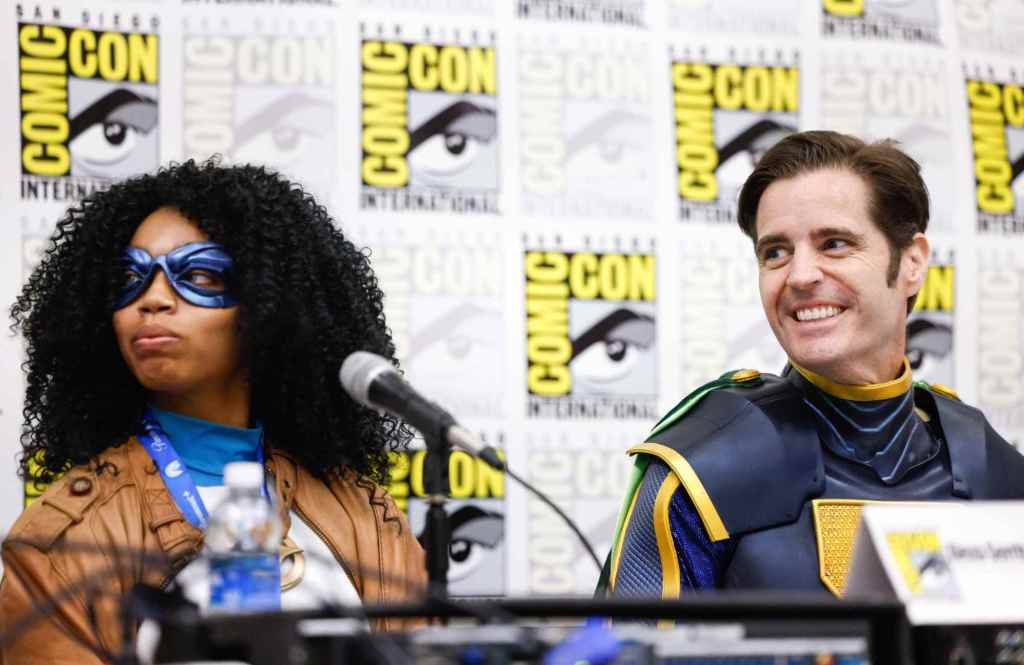Air quality concerns in San Ysidro. Kumeyaay history and culture. Fighting hunger throughout San Diego County.
These were some of the local issues San Diego people brought to a discussion panel at Comic-Con this year.
The international convention is best known for hosting cosplayers and Hollywood stars talking about their latest movies, but local creators and organizers are using its popularity to raise awareness of social issues through art.
The key part of that? Making it fun and accessible.
“I always ask myself: How do I get people’s attention?” said Ethan Vanegas, a lecturer at San Diego State University, who was participating in a panel discussing his longtime effort to create a comic book about the history of the Kumeyaay people of San Diego County. “The entertainment element is very important.”
Comic-Con has held panels about Kumeyaay visual storytelling projects over the past few years and has been “very supportive and receptive” to the creators’ efforts, Vanegas said.
Typically, Comic-Con panels allow attendees to hear their favorite actors, producers, and artists talk about their work. After last year’s strike kept most attendees away, this year many Hollywood stars returned to Comic-Con.
But amid the celebrity festivities, the tournament also offers San Diego residents a chance to find out what’s going on in their local community and how they can get involved.
This year’s panel brought together local educators from Helix Charter High School, Fester Charter High School and University of California, San Diego to explain how esports impact students’ emotional intelligence, using specific examples from San Diego schools.
Another panel focused on the nonprofit organization Feeding San Diego’s efforts to engage young people in addressing food insecurity through comics and art.
Panelists said Comic-Con allows them to introduce more complex themes to audiences without overwhelming them.
“It highlights local issues and gives legitimacy where there’s been a lack of legitimacy,” said Johnny Bear Contreras, a public artist and member of the San Pasqual Band of Mission Indians, “and does it with a very casual approach.”
This year, Contreras participated in a panel discussion to discuss his role as set designer for “Somos Aire,” a comic adaptation of a local play that portrays concerns about air pollution caused by traffic in San Ysidro, where thousands of cars cross the U.S.-Mexico border every day.
Fellow panelist playwright Mabel Reynoso said she hopes to turn the play into a comic book so it can reach a wider audience.
“We know that theater has limitations in terms of logistics and access, especially for communities of color,” Reynoso says, “and what better way to spread great stories than by putting them in comic books?”
Vanegas agrees that the medium matters: Although books about the Kumeyaay deal with dark themes like colonization and language loss, the comic book format is an innovative way to teach people the history. It’s like a “Trojan horse,” he says.
The panelists also hope that these conversations at Comic-Con will inspire people, especially young people, to get more involved in social activism.
 Dana Williams (center), communications director for Feeding San Diego, sees more opportunities to spotlight local issues at Comic-Con. (Meg McLaughlin / San Diego Union-Tribune)
Dana Williams (center), communications director for Feeding San Diego, sees more opportunities to spotlight local issues at Comic-Con. (Meg McLaughlin / San Diego Union-Tribune)
Earlier this year, Dana Williams, director of marketing and communications for Feeding San Diego, spoke on a panel about the nonprofit’s project to create a comic book called “Hunger Action Heroes Unite!,” which is out now and available for purchase on Feeding San Diego’s online store.
The book grew out of Feeding San Diego and Comic-Con Museum’s 2022 art contest, in which San Diego County students submitted designs for hungry heroes. The two winners’ designs became the inspiration for a new comic book that tells the superheroes’ origin stories.
Williams said the nonprofit aims to “educate the public about the issues of hunger and food waste, get them interested and want to be part of the solution.”
She believes there’s “untapped potential” in creating more collaborations like this between Comic-Con and local organizations to “make purpose part of the DNA of the event.”
Comic-Con spokesman David Glanzer said in an email that the convention’s mission is to promote the arts, but “we love it even more when that art inspires change and action.”
Comic-Con considers diversity of presentations when selecting panels, and encourages potential panelists next year to pitch ideas that will reach a wide audience, he said.
The panelists know they have to compete for attention with the larger celebrity panels at Comic-Con, but they’re not worried about that.
Ultimately, Comic-Con attracts people with a huge variety of interests, Reynoso said.
“Comic-Con brings together people from all walks of life, so it’s not surprising that many attend and use it as a platform for advocacy,” she said.
“They might come to see the latest film or get an autograph from an artist, and then realize afterwards, ‘Oh, I went to this panel and it got me thinking about something I’d never thought about before.'”
First published: July 27, 2024, 5:00 AM


